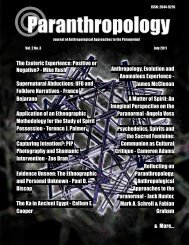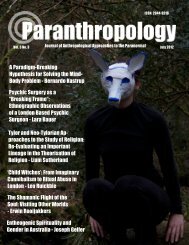Psi and Psychedelics - Paranthropology - Weebly
Psi and Psychedelics - Paranthropology - Weebly
Psi and Psychedelics - Paranthropology - Weebly
You also want an ePaper? Increase the reach of your titles
YUMPU automatically turns print PDFs into web optimized ePapers that Google loves.
PARANTHROPOLOGY: JOURNAL OF ANTHROPOLOGICAL APPROACHES TO THE PARANORMAL VOL. 2 NO. 2<br />
dreaming, trances, <strong>and</strong> various other “altered”<br />
states), the logical <strong>and</strong> rational versus the dream<br />
world <strong>and</strong> magical, or simply Consciousness A<br />
<strong>and</strong> Consciousness B. Effectively the cerebrum<br />
dominates waking consciousness <strong>and</strong> the<br />
cerebellum dominates unconsciousness <strong>and</strong><br />
dreaming. But there is much more to it than this.<br />
The cerebellum is primarily responsible<br />
for the phenomena that we refer to as<br />
paranormal, <strong>and</strong> these may burst forth,<br />
manifesting themselves even as our waking<br />
consciousness may try to suppress them. So the<br />
waking consciousness of a “normal <strong>and</strong> sane<br />
person”, stressing rationality <strong>and</strong> logic, may deny<br />
or suppress paranormal manifestations, while a<br />
“psychologically or psychiatrically disturbed”<br />
person may break ties to a greater or lesser extent<br />
with “reality” (as defined by conventional<br />
waking consciousness) <strong>and</strong> thus be open to, <strong>and</strong><br />
even create, paranormal phenomena. In some<br />
cases (either through training or perhaps through<br />
simple innate ability), however, an individual<br />
may be able to juggle both the rational <strong>and</strong> the<br />
paranormal phenomena simultaneously in a<br />
productive matter (opening one’s self up to<br />
telepathic exchanges, for instance), or quickly<br />
(perhaps seamlessly) switch back <strong>and</strong> forth<br />
between one <strong>and</strong> the other. Certain contexts, such<br />
as during a séance, in a ritual setting, or the<br />
active pursuit of ceremonial, sexual, or natural<br />
magic, may enhance the development of<br />
paranormal manifestations.<br />
All of us have both a cerebrum <strong>and</strong> a<br />
cerebellum (according to Gooch, women have on<br />
average larger cerebellums than men). The<br />
cerebrum in modern humans, Cro-Magnons<br />
(generally viewed as our direct ancestors), <strong>and</strong><br />
ancient Ne<strong>and</strong>erthals is the larger of the two<br />
brains, <strong>and</strong> dominates our waking consciousness.<br />
However, compared to modern humans <strong>and</strong> Cro-<br />
Magnons, the ancient Ne<strong>and</strong>erthals had much<br />
larger cerebellums. By Gooch’s theory, the larger<br />
cerebellums of Ne<strong>and</strong>erthals meant that they had<br />
enhanced intuitive <strong>and</strong> psychic abilities relative<br />
to Cro-Magnons <strong>and</strong> us. Furthermore, according<br />
to Gooch, modern humans are the result of both<br />
biological <strong>and</strong> cultural hybridization between<br />
Ne<strong>and</strong>erthals <strong>and</strong> Cro-Magnons. Thus the duality<br />
between consciousness <strong>and</strong> unconsciousness,<br />
waking <strong>and</strong> dreaming, the rational <strong>and</strong> the<br />
paranormal, in modern humans is also an<br />
inheritance from the two lineages that gave rise<br />
to us—Cro-Magnons <strong>and</strong> Ne<strong>and</strong>erthals.<br />
Gooch generalized his theory of duality<br />
even further, writing (Gooch, 1978, p. 209),<br />
“Cerebellum <strong>and</strong> cerebrum,<br />
Ne<strong>and</strong>erthal <strong>and</strong> Cro-Magnon,<br />
female <strong>and</strong> male are all aspects<br />
of a still larger process. This is the<br />
interaction of ‘libido’ <strong>and</strong><br />
‘aggression’. Libido is Freud’s<br />
name for the energy of the<br />
unconscious. Aggression requires<br />
no special definition. These two<br />
forms of energy seem to run side<br />
by side through all life, even in a<br />
rudimentary sense in single-celled<br />
organisms. Libido is always<br />
concerned with inward affairs<br />
(rather like the autonomic nervous<br />
system) <strong>and</strong> aggression with<br />
external affairs (like the central<br />
nervous system).”<br />
This brief description of Gooch’s theories <strong>and</strong><br />
lifework certainly does not do it justice; we<br />
encourage the interested reader to pursue<br />
Gooch’s published works. Furthermore, like any<br />
good scientific theory, Gooch’s ideas are subject<br />
to testing <strong>and</strong> further elaboration, something that<br />
we are actively pursuing, including through firsth<strong>and</strong><br />
study of paranormal phenomena (see for<br />
instance, Schoch <strong>and</strong> Ghiocel, 2009) <strong>and</strong> through<br />
the reconstruction, based on the surviving<br />
physical remains, of the ancient ways of<br />
Ne<strong>and</strong>erthal life, ritual, <strong>and</strong> thought (Ghiocel <strong>and</strong><br />
Schoch, 2011).<br />
A final comment: Stan Gooch may never<br />
have heard the term “paranthropologist”, but<br />
when it came right down to it, that is exactly<br />
what he was—<strong>and</strong> a first-rate paranthropologist<br />
at that. We conclude with a short quotation from<br />
Gooch (1978, p. vi) summarizing his outlook in a<br />
dozen words:<br />
References<br />
“The paranormal is the most<br />
glorious gift that life has to offer.”<br />
51 PARANTHROPOLOGY: JOURNAL OF ANTHROPOLOGICAL APPROACHES TO THE PARANORMAL




